Borneo
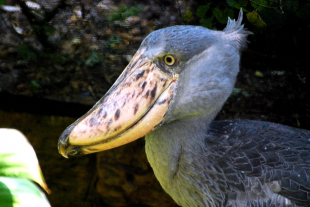
Shoebill stork, Balaeniceps rex
Being entirely gray the Shoebill is easily recognized, even without its most distinguishable feature which gives it its name – a bill that resembles a hook-tipped Dutch clog . The head is large in proportion to the body, and the many-colored bill is wide and thick, The hooked bill is 8 – 12 inches (20 – 25 cm) long, 4 – 5 inches (10 – 13 cm) wide and has cutting edges. It has yellow eyes and extremely long toes. Males and females have similar coloration with small crest or white tufts sticking out from the back of the head. The tail is rounded. The tan beak often has dark spots. The legs are skinny and long, like the legs of most wading birds; feet are unwebbed.
LEARN MORE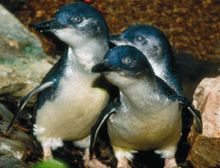
Blue penguin, Eudyptula minor
Standing 16 inches in height and weighing three pounds, this is the smallest penguin species. It is estimated that over a million live in Southern Australia, Tasmania, and New Zealand, sometimes not far from large cities. “Penguin parades”, where they march across the beach from the surf to their burrows in the sand, are popular tourist attractions. Several Fairy or Blue penguins have been hatched at the DWA, where they have been kept since 2002.
LEARN MORE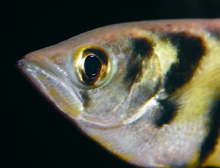
Banded archerfish, Toxotes jaculatrix
By pressing its tongue against a bony groove in the roof of its mouth, an archerfish can shoot a jet of water as far as ten feet to knock down the insects it eats. Possessing remarkable eyesight, they can also compensate for defraction, so they have excellent aim. They are typical inhabitants of mangrove swamps and river mouths in Southeast Asia and other parts of the Western Pacific. This species tolerates a wide range of salinities, including freshwater.
LEARN MORE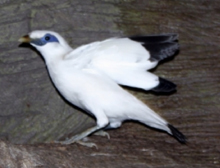
Bali mynah, Leucopsar rothschildi
Unknown to science until 1912, this gorgeous starling was first bred in captivity in 1931. Since the 1960s, thousands have been bred in zoos around the world (including the DWA), resulting in a self-sustaining genetically healthy population. On its native island of Bali, in Indonesia, its population fell to a dozen by 1999, due to illegal trapping. Recent attempts to reintroduce it to the wild have been encouraging.
LEARN MORE
Palm cockatoo, Probosciger aterrimus
This magnificent parrot is found in New Guinea, Australia’s Cape York Peninsula and nearby islands. Unlike some other cockatoos, it is a true forest bird. The skin on its cheeks can change color rapidly. It has proven more difficult to breed in captivity than most parrots.
LEARN MORE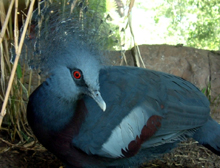
Victoria crowned pigeon, Goura victoria
The largest members of the pigeon and dove family, the three species of crowned pigeons are found only in New Guinea and small nearby islands. All have powder-blue feathers and red eyes, but this species is distinguished by the unique “tabs” on its crest. Though capable of flight, it is usually found on the ground. It does well in captivity and has been bred in many collections.
LEARN MORE
Matschie’s tree kangaroo, Dendrolagus matschiei
One of the world’s more brightly colored mammals, this marsupial is found only in the Huon Peninsula in Eastern New Guinea. It has only occasionally been exported for zoos, so that the North American zoo population of around fifty animals is carefully managed to make sure that, despite a limited gene pool, coming generations continue to be bred. One born at the DWA in 2007, was welcomed as particularly genetically valuable, and is now on breeding loan to the Calgary Zoo.
LEARN MORE
Rhinoceros hornbill, Buceros rhinoceros
This bird is dependent on the continued existence of old growth forests in Southeast Asia. Outside the breeding season, it eats a wide variety of fruits, supplemented with small animals while it raises chicks. The nest is a deep hole in a tall tree into which the female is sealed by the male, with a cement-like mixture of mud, feces and fruit; she remains inside for weeks. Except for their eye color (males have red eyes and females have white eyes), males and females look alike. Not bred in captivity until 1986, this species is now managed as an international zoo population.
LEARN MORE
Moluccan cockatoo, Cacatua moluccensis
Found only on the Indonesian islands of Seram, Saparua and Haruku, this parrot has long been popular with collectors. It was kept in Europe as early as 1601 and centuries before in China. Trapping for the pet trade had made it a highly endangered bird by the 1980s but many are now bred in captivity. It can live more than 60 years.
LEARN MORE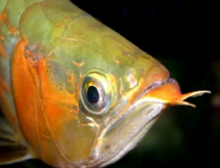
Asian arowana, Scleropages formosus
Described to science in 1844, it was thought there was only a single species of Asian arowana until 2003, when a team of three ichthyologists determined that there were actually four species. These had previously been considered color phases (like black leopards or jaguars, or white tigers). This classification is controversial. All populations of the Asian arowana are considered endangered, primarily due to habitat destruction. In the past, they were considered threatened by the commercial aquarium trade, but farm-raised specimens, sold micro-chipped, with “birth certificates” now supply the demand for these “Dragon Fishes”, which, in some Asian traditions, are considered to bring luck to businesses where they are kept.
LEARN MORE

